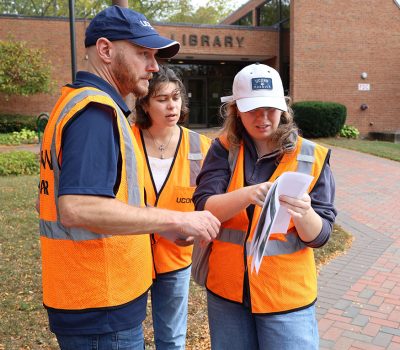NEW in June 2025! E-Corps was selected by the American Association for the Advancement of Science (AAAS) and the National Science Foundation to write an article summarizing the triumphs and tribulations of the program. It’s the most comprehensive read on E-Corps yet — and it’s mercifully brief!
Tackling Real-World Problems: Impacts, Observations, and Challenges after Seven Years of the Environment Corps
 As the flagship university of the State of Connecticut and a Land/Sea Grant university, the University of Connecticut (UConn) has a mission to be an Engaged Institution, developing and sustaining meaningful, mutually beneficial engagement with the communities of the state.
In the course of our research and Extension work, we’ve become aware of the enormous pressures that our state’s communities are under – some of which relate to protecting their town’s natural resources and responding to a long list of environmental requirements. UConn is also committed to providing Life Transformative Education for its students. And as instructors, we continually marvel at the quality of work that can be done by undergraduates once they are given the knowledge and tools to tackle a particular problem. The E-Corps is our attempt to marry these two factors to the benefit of the students, the communities, and the university.
As the flagship university of the State of Connecticut and a Land/Sea Grant university, the University of Connecticut (UConn) has a mission to be an Engaged Institution, developing and sustaining meaningful, mutually beneficial engagement with the communities of the state.
In the course of our research and Extension work, we’ve become aware of the enormous pressures that our state’s communities are under – some of which relate to protecting their town’s natural resources and responding to a long list of environmental requirements. UConn is also committed to providing Life Transformative Education for its students. And as instructors, we continually marvel at the quality of work that can be done by undergraduates once they are given the knowledge and tools to tackle a particular problem. The E-Corps is our attempt to marry these two factors to the benefit of the students, the communities, and the university.
Why We're Doing This
 As the flagship university of the State of Connecticut and a Land/Sea Grant university, the University of Connecticut (UConn) has a mission to be an Engaged Institution, developing and sustaining meaningful, mutually beneficial engagement with the communities of the state.
In the course of our research and Extension work, we’ve become aware of the enormous pressures that our state’s communities are under – some of which relate to protecting their town’s natural resources and responding to a long list of environmental requirements. UConn is also committed to providing Life Transformative Education for its students. And as instructors, we continually marvel at the quality of work that can be done by undergraduates once they are given the knowledge and tools to tackle a particular problem. The E-Corps is our attempt to marry these two factors to the benefit of the students, the communities, and the university.
As the flagship university of the State of Connecticut and a Land/Sea Grant university, the University of Connecticut (UConn) has a mission to be an Engaged Institution, developing and sustaining meaningful, mutually beneficial engagement with the communities of the state.
In the course of our research and Extension work, we’ve become aware of the enormous pressures that our state’s communities are under – some of which relate to protecting their town’s natural resources and responding to a long list of environmental requirements. UConn is also committed to providing Life Transformative Education for its students. And as instructors, we continually marvel at the quality of work that can be done by undergraduates once they are given the knowledge and tools to tackle a particular problem. The E-Corps is our attempt to marry these two factors to the benefit of the students, the communities, and the university.